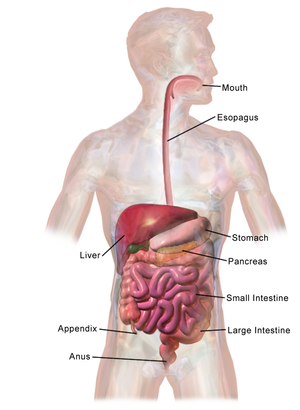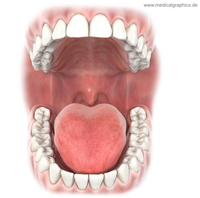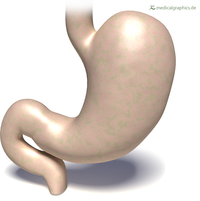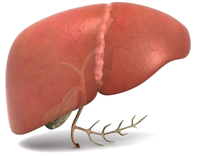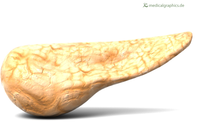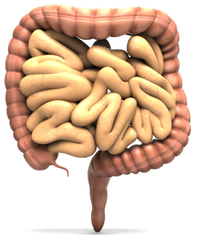Digestive System
Contents
Key Stage 2
Meaning
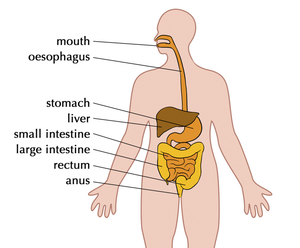
A diagram of the digestive system.
The digestive system is the parts of the body that we use to get nutrients out of our food.
About The Digestive System
- The digestive system breaks food down into small pieces.
- The small pieces can then be absorbed into the body.
- The bits the body does not need leave the body as faeces.
- The digestive system is made up of several parts:
Key Stage 3
Meaning
The digestive system is an organ system that breaks down food for absorption into the blood.
About The Digestive System
- The digestive system breaks down food mechanically and chemically before absorbing nutrients into the blood.
- The digestive system takes large insoluble molecules and breaks them down into small soluble molecules to be absorbed.
There are several organs in the digestive system you should know:
- Mouth - Breaks down food mechanically with teeth and adds saliva using the salivary glands to make food easier to swallow.
- Oesophagus - Uses peristalsis to move food from the mouth to the stomach.
- Stomach - Starts chemical digestion of food in an acidic environment.
- Liver - Makes bile to neutralise stomach acid and break down fat.
- Pancreas - Makes enzymes to chemically digest food.
- Small Intestine - Absorbs food into the blood through villi
- Large Intestine - Absorbs water from undigested food called faeces.
- Rectum - Stores faeces before egestion.
- Anus - A ring of muscle that holds faeces in.
| The mouth is an organ is used to start digestion of food. | The oesophagus is an organ that connects the mouth to the stomach. | The stomach is an organ that digests food. |
| In the digestive system the liver produces bile which neutralises the acid from the stomach and helps break down fat. | In the digestive system the pancreas produces enzymes to chemically break down food. |
|
Key Stage 4
Meaning
The digestive system is an organ system that breaks down food for absorption into the blood.
About The Digestive System
- The digestive system breaks down food mechanically and chemically before absorbing nutrients into the blood.
- The digestive system takes large insoluble molecules and breaks them down into small soluble molecules to be absorbed.
There are several organs in the digestive system you should know:
- Mouth - Breaks down food mechanically with teeth and adds saliva using the salivary glands to lubricate the food for it to be swallowed.
- Oesophagus - Uses peristalsis to move food from the mouth to the stomach.
- Stomach - Starts chemical digestion of food in an acidic environment adding a protease called pepsin which breaks down proteins into amino acids.
- Liver - Makes bile to neutralise stomach acid and emulsify fat.
- Pancreas - Makes digestive enzymes including pancreatic amylase, trypsin (which is a type of protease and lipase.
- Small Intestine - Continues the chemical digestion of food using the enzymes from the pancreas as well as producing its own amylase and peptidase. It then absorbs food into the blood through villi
- Large Intestine - Absorbs water from undigested food called faeces.
- Rectum - Stores faeces before egestion.
- Anus - A ring of muscle that holds faeces in.
| The mouth is an organ is used to start digestion of food. | The oesophagus is an organ that connects the mouth to the stomach. | The stomach is an organ that digests food. |
| In the digestive system the liver produces bile which neutralises the acid from the stomach and helps break down fat. | In the digestive system the pancreas produces enzymes to chemically break down food. |
|
